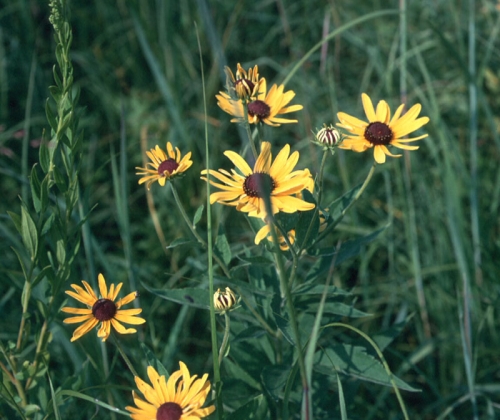Plants and Animals
Rudbeckia subtomentosa Sweet coneflower
Key Characteristics
Tall forb; stems densely pubescent, bearing alternate leaves deeply 3-lobed; flower sunflower-like, with yellow rays and a dark reddish-purple disk; chaff of the receptacle rounded and glandular-pubescent at the tip.
Status and Rank
US Status: No Status/Not Listed
State Status: X - Presumed extirpated (legally 'threatened' if rediscovered)
Global Rank: G5 - Secure
State Rank: SX - Presumed extirpated
Occurrences
| County | Number of Occurrences | Year Last Observed |
|---|---|---|
| Gratiot | 1 | 1894 |
Information is summarized from MNFI's database of rare species and community occurrences. Data may not reflect true distribution since much of the state has not been thoroughly surveyed.
Habitat
Although Michigan's sole collection from 1894 is noted as being collected in a "swamp" near Alma, the noted locale on the specimen is considered suspicious. Elsewhere, just outside southwest Michigan, this species occurs on the edges of moist open woods and thickets adjacent to prairies. It also occurs in sandy prairies and in bottomlands of the Kankakee River. The species is also occasionally used in grassland plantings.
Natural Community Types
- Bur oak plains
- Dry-mesic prairie
- Floodplain forest
- Mesic prairie
- Oak openings
- Southern hardwood swamp
- Wet-mesic sand prairie
For each species, lists of natural communities were derived from review of the nearly 6,500 element occurrences in the MNFI database, in addition to herbarium label data for some taxa. In most cases, at least one specimen record exists for each listed natural community. For certain taxa, especially poorly collected or extirpated species of prairie and savanna habitats, natural community lists were derived from inferences from collection sites and habitat preferences in immediately adjacent states (particularly Indiana and Illinois). Natural communities are not listed for those species documented only from altered or ruderal habitats in Michigan, especially for taxa that occur in a variety of habitats outside of the state.
Natural communities are not listed in order of frequency of occurrence, but are rather derived from the full set of natural communities, organized by Ecological Group. In many cases, the general habitat descriptions should provide greater clarity and direction to the surveyor. In future versions of the Rare Species Explorer, we hope to incorporate natural community fidelity ranks for each taxon.
Associated Plants
No associates have been documented for Michigan. Associates elsewhere include New England aster, tall coreopsis, bottle gentian, blazing star, rosin weed, Riddell's goldenrod, seedbox, big bluestem, downy sunflower, stiff goldenrod, short-fruited rush, mountain mint, black-eyed Susan, tall nut-rush, and common spiderwort.
Management Recommendations
The primary need for this species is a status survey in the vicinity of the former collection. However, this species is more likely to be found in southwest Michigan, and thus could be sought within prairie remnants there.
Survey Methods
Random meander search covers areas that appear likely to have rare taxa, based on habitat and the judgment of the investigator.
-
Meander search
-
Survey Period: From first week of August to fourth week of August
-
References
Survey References
- Elzinga, C.L., D.W. Salzer, and J.W. Willoughby. 1998. Measuring and Monitoring Plant Populations. The Nature Conservancy and Bureau of Land Management, Denver. BLM Technical Reference 1730-1. 477pp.
- Goff, G.F., G.A. Dawson, and J.J. Rochow. 1982. Site examination for Threatened and Endangered plant species. Environmental Management 6(4): 307-316
- Nelson, J.R. 1984. Rare Plant Field Survey Guidelines. In: J.P. Smith and R. York. Inventory of rare and endangered vascular plants of California. 3rd Ed. California Native Plant Society, Berkeley. 174pp.
- Nelson, J.R. 1986. Rare Plant Surveys: Techniques For Impact Assessment. Natural Areas Journal 5(3):18-30.
- Nelson, J.R. 1987. Rare Plant Surveys: Techniques for Impact Assessment. In: Conservation and management of rare and endangered plants. Ed. T.S. Elias. California Native Plant Society, Sacramento. 8pp.
Technical References
- Antonio, T.M. and S. Masi. 2001.The Sunflower Family in the Upper Midwest. A Photographic Guide to the Asteraceae in Illinois, Indianan, Iowa, Michigan, Minnesota and Wisconsin. Indiana Academy of Science, Indianapolis. 421pp.
- Deam, C. C. 1940. Flora of Indiana. Department of Conservation, Indianapolis. 1236pp.
- Flora of North America Editorial Committee. 2006. Flora of North America, North of Mexico. Volume 21: Magnoliophyta: Asteridae (in part): Asteraceae, part 3. Oxford University Press, New York. 616pp.
- Gleason, H. A., and A. Cronquist. 1991. Manual of Vascular Plants of Northeastern United States and Adjacent Canada. Second edition. The New York Botanical Garden, Bronx. 910pp.
- Gray, A. 1950. Gray's Manual of Botany; eighth ed. Van Nostrand Reinghold, New York. 1632pp.
- Holmgren, N.H. 1998. Illustrated Companion to Gleason and Cronquist's Manual. Illustrations of the vascular plants of Northeastern United States and adjacent Canada. New York Botanical Garden, Bronx. 937pp.
- Mohlenbrock, R.H. 1986. Guide to the Vascular Flora of Illinois. Southern Illinois University Press, Carbondale. 507pp.
- Swink, F. and G. Wilhelm. 1994. Plants of the Chicago Region, 4th ed. Indiana Academy of Science, Indianapolis. 921pp.
- Voss, E.G. 1996. Michigan Flora. Part III. Dicots (Pyrolaceae-Compositae). Bulletin of the Cranbrook Institute of Science and University of Michigan Herbarium. 622pp.


